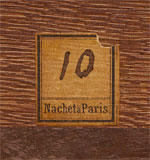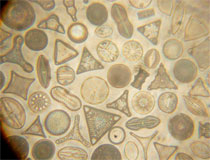 |
|||||
 |
 |
||||
 |
|||||
 |
 |
||||
French Compound Box Microscope (No. 128 ) |
|||||||||||
 |
Age: c1760 Made by: unknown Made in: France |
||||||||||
 |
|||||||||||
|
The microscope was part of the Nachet Collection displayed at the 1900 Paris Universal Exhibition.
|
|||||||||||
 |
|||||||||||
|
Imaging
|
|||||||||||
|
This microscope is a Box Microscope made in 18th Century France. It consists of a double microscope mounted through a support pillar to a steel frame encased in an elaborate, curved box inlaid with marquetery. It is supported at the base by four bronze feet. The box has a single drawer into which extra objectives and accessories are stored. The microscope support pillar is triangular in cross section and has the coarse focusing rack machined into the back vertex. The matching pinion is mounted on the fixed pillar and is controlled by two knurled knobs. Fine focus is controlled by an elaborate steel worm gear mechanism encased inside the box. It is controlled by a large knob on the left side of the box. The optics of the microscope are typical of that era. There are only three simple lenses inside the body tube: eye, field, and objective lenses. All are biconvex. The eye and field lenses are held in place in the drawtube by Lignum vitae collars. The microscope can be rotated into the "aquatic" position, or translated laterally using a knurled knob attached to a two-plate mechanism on the top of the support pillar. The internal illuminating mirror is controlled by a handle located on the right side of the box. The only accessories are two wooden microscope specimen slides and an interesting ivory white disc. Imaging is good at low magnification, but suffers from aberrations and poor contrast at high magnifications. The microscope body, cantilever mount, sample stage, specimen holders, and control knobs appear to be made of ormalu, or gilt bronze. Ormolu is an artistic gold layer over bronze that was popular in 18th Century France. Clay and Court (1932) describe another French box microscope (Fig 94) possessing ormolu specimen mounts that are identical to the two on this instrument. Box microscopes were a style of microscope popular in France and Germany during the 18th century. They consisted of a microscope body supported by a single pillar, which was mounted on a wooden box. The box style ranged from simple mahogany or fruit wood to elaborate marquetry such as is exemplified with this microscope in the Golub Collection. Inside the box was usually a single drawer and the illuminating mirror. The mirror was mounted on a simple pivot, not the more usual gimbal. This microscope was No. 43 of the former Nachet Collection of Paris. Albert Nachet described this instrument as "-- rare, particularly remarkable and resembles the mechanisms used in modern microscopes. It is the only instrument to our knowledge with such a perfect fine adjustment." The Golub Collection has several box microscopes, many of which were original members of the Nachet Collection. |
|||||||||||
Microscope featured 11/2012; 12/2021